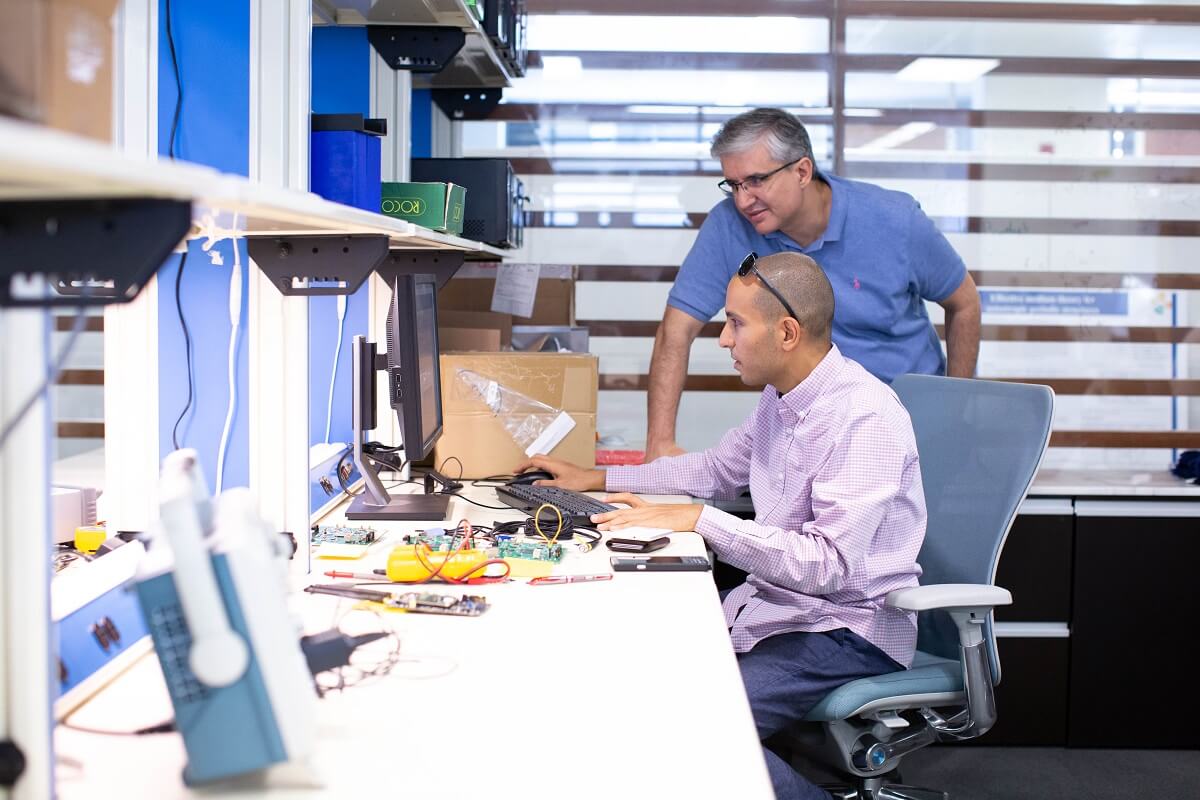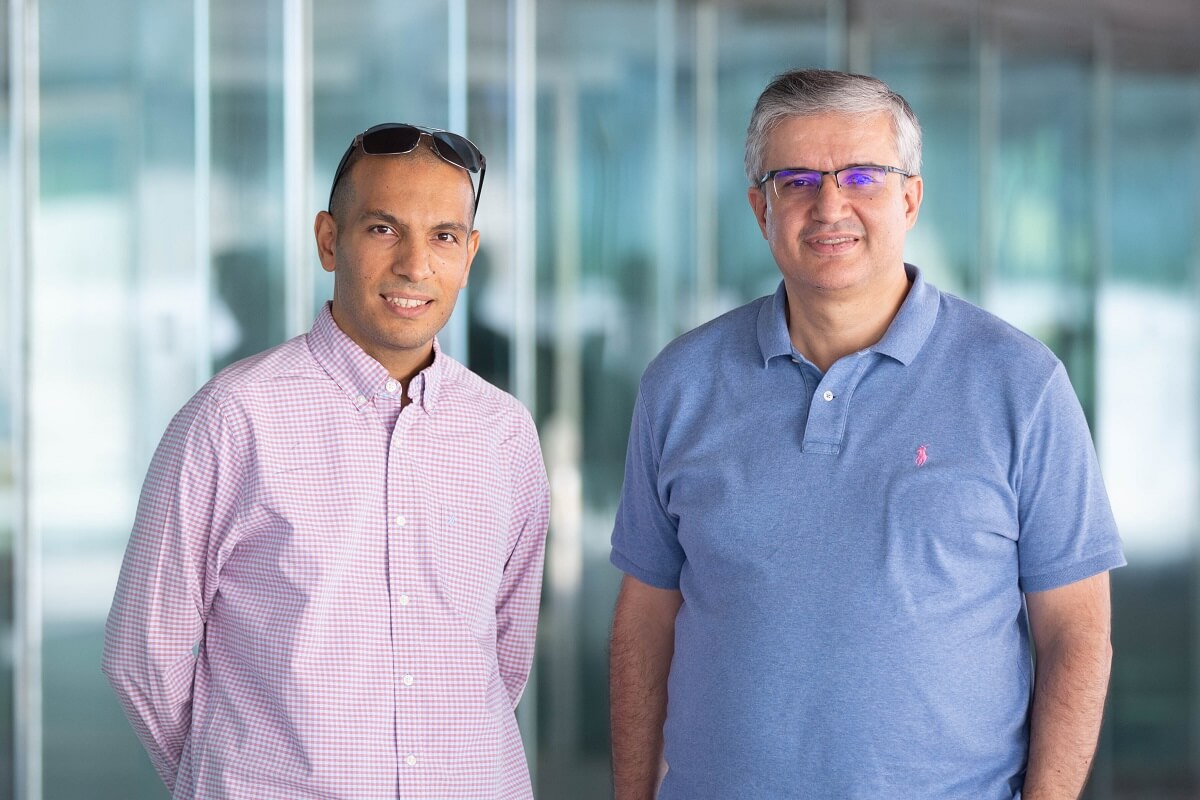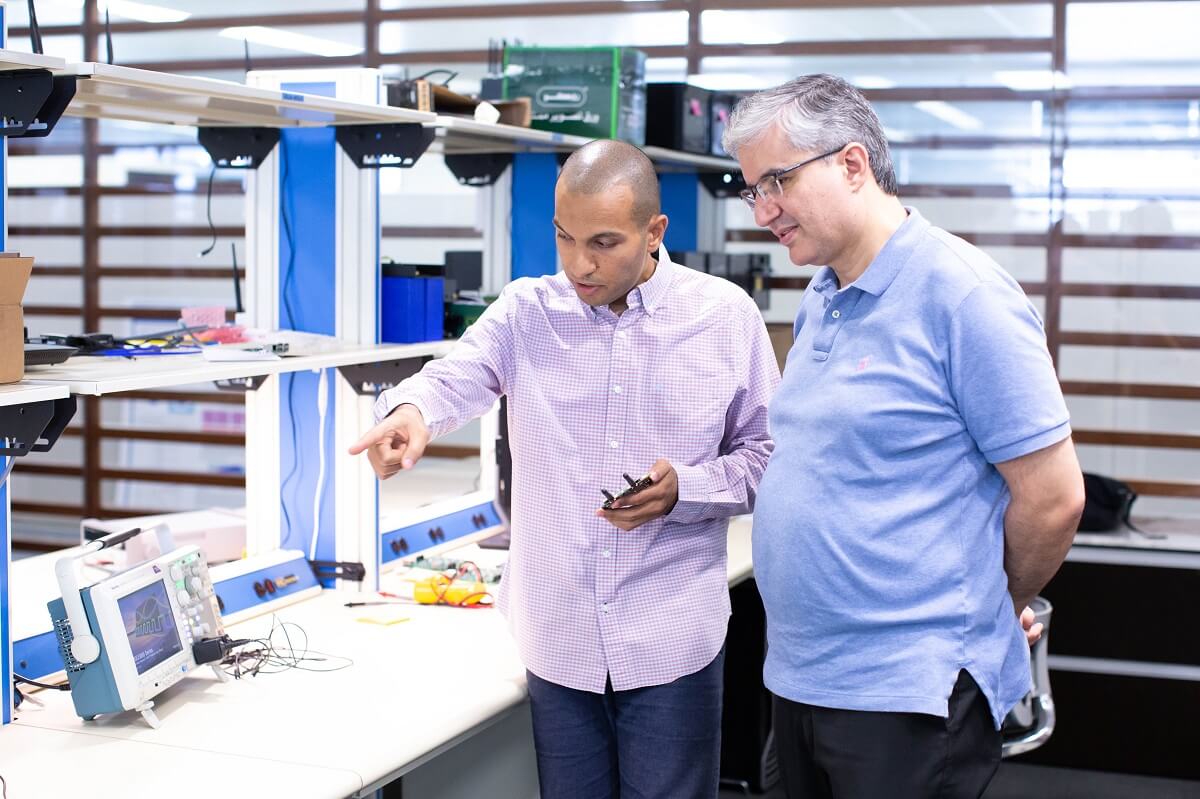Teamwork pays off at startup Insyab

Dr. Ahmed Bader (seated), a former KAUST postdoctoral fellow, and KAUST Professor Mohamed-Slim Alouini (standing) founded startup Insyab, which provides smart solutions allowing robots and drones to collaborate on the execution of common tasks. Photo by Khulud Muath.
By Abdullah Alhamdan, KAUST News
Insyab, a technology startup specializing in smart solutions allowing robots and drones to collaborate on the execution of common tasks, resulted from three years of its founders' dedicated research at KAUST.
"I founded Insyab in cooperation with KAUST Professor Mohamed-Slim Alouini," stated Dr. Ahmed Bader, Insyab's general manager. "This was only natural, as I had worked with him as a postdoctoral fellow on his research team at the University for about three years. Professor Slim is well-known and has extensive experience in the field of wireless connectivity, [and] I have worked at several industrial companies in the region and beyond. I have over 10 years of experience directly related to Insyab's business."
Direct interaction with companies and industrial facilities—particularly those operating in different energy sectors—also inspired the team to establish Insyab. They realized the need for intelligent, efficient and low-cost systems for imaging, mapping and scanning missions using robots and drones, Bader explained.
"Our initial research focus was on coming up with innovative solutions that would allow teams of unmanned autonomous vehicles to complete time-critical mapping and survey missions most efficiently," Bader continued. "The University provided an incubator for basic research and support for prototyping as a first step toward final product development."
Unleashing the power of collaboration
Insyab's standout product is AirFabric™, a broadband ultra-low-latency wireless connectivity solution allowing a team of unmanned vehicles (i.e., robots, drones, etc.) and even humans to effectively collaborate.
Products existing in the market previously were limited to the use of one vehicle, but it is more logical and efficient to operate several automated vehicles at once to cover a larger area and to save time when completing a job.
However, available communications and technological solutions could not manage several automated vehicles effectively and simultaneously. Thus was born the idea of developing a product that filled the gap and offered solution developers the opportunity to build multi-vehicle systems.

The Insyab team—which includes Dr. Ahmed Bader (left), Insyab general manager, and KAUST Professor Mohamed-Slim Alouini (right)—created AirFabric™, a broadband ultra-low-latency wireless connectivity solution allowing a team of unmanned vehicles and even humans to effectively collaborate. Photo by Khulud Muath.
Instead of working in silos, Insyab's technology allow robots to interact in real time, share their learning and effectively perform the underlying mission. It literally unlocks a "1+1=3" type of value proposition.
"The most notable applications for AirFabric™ today are in imaging, mapping and scanning missions, as it is designed to cater for use cases where real-time flow of information matters. Situations like these are often found in law enforcement; disaster relief and emergency responses; crowd surveillance; and oil exploration," he stated.
Saving lives through robotics
In a search and rescue context for example, the use of AirFabric™ in conjunction with a vision-powered swarm of drones can help reduce the chance of missing a survivor by five times. The novel path planning technology allows the fleet of drones to dynamically and continuously optimize their flight trajectories.

Insyab team members Dr. Ahmed Bader (left), Insyab general manager, and KAUST Professor Mohamed-Slim Alouini (right) work together on campus on their technologies. Photo by Khulud Muath.
"Insyab currently has three granted patents and three more pending and has created a direct added value in terms of realizing external revenues because all its clients are from America and Europe," he added.
Advice for young entrepreneurs
"Building a startup requires a lot of patience and perseverance and the ability to deal with difficulties," noted Bader. "I'm not exaggerating when I say that research and scientific innovation represent only 20 percent of the momentum necessary to move the company forward."
He advised aspiring entrepreneurs to not rush to achieve results, especially if the company's product is based on research or a scientific project.
"I think that sticking to an idea despite difficulties in convincing the market may be an indication of the futility of continuing on the same path—although I'm not saying it's an indication to retreat! The most important force behind persistence and achievement is the founders' strong belief in what they are doing 100 percent," he stated.
The Insyab team is now working on developing the second version of their product, and they expect it to be ready before the end of the year.
"We hope this upgraded version of our product will help us expand into new markets over the coming years," Bader said.

